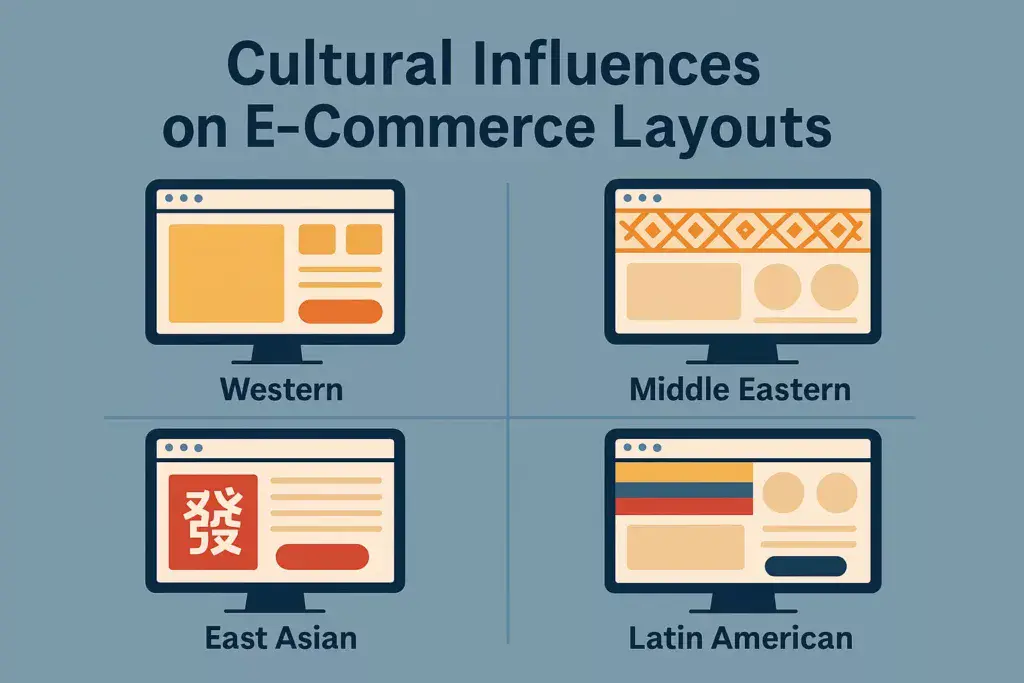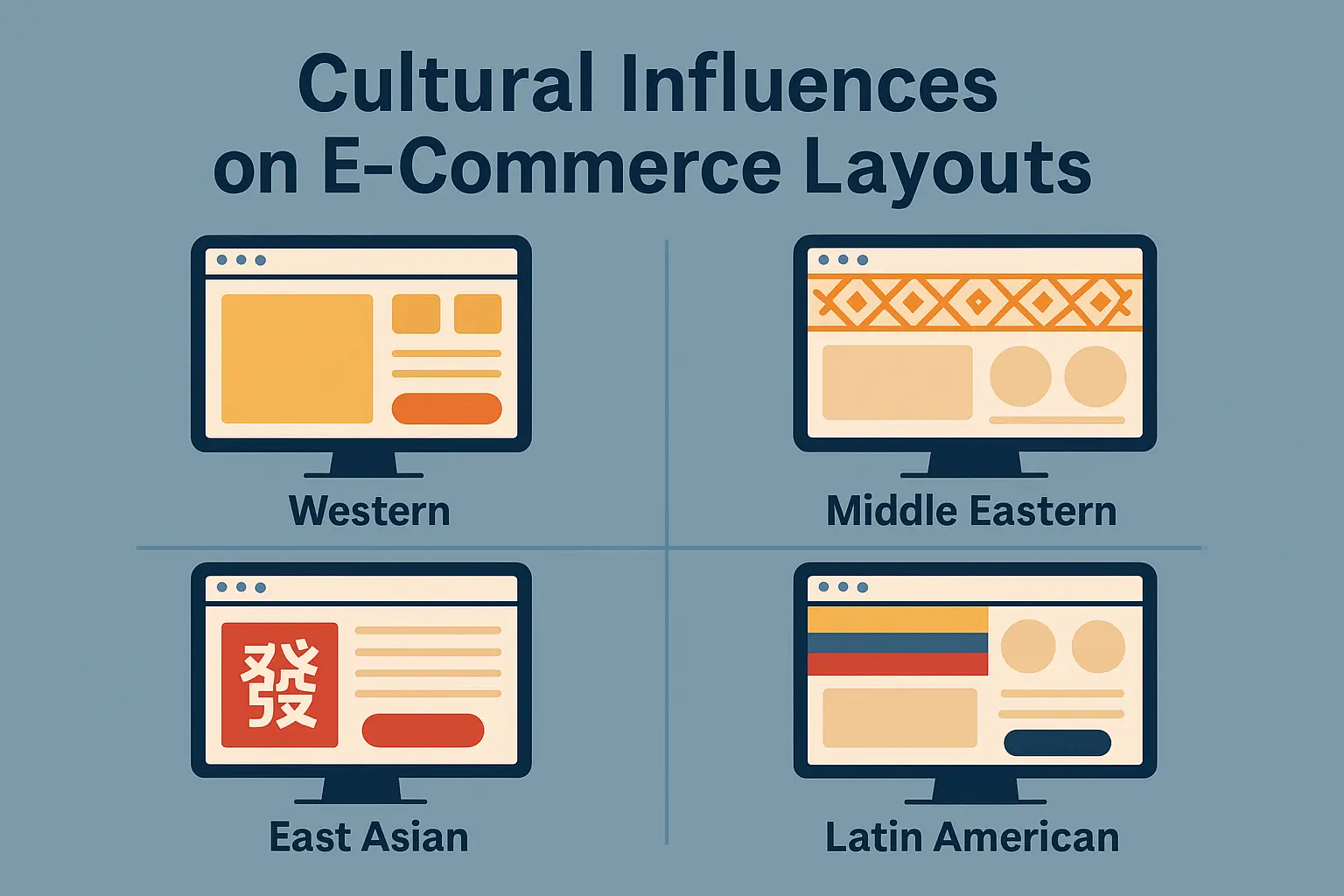
I. Introduction to Cultural Influences on E-Commerce Layouts in E-Commerce Design
In today’s global marketplace, e-commerce businesses are no longer confined to local markets; they now serve diverse audiences across various cultures and regions. As a consequence, understanding and incorporating cultural influences into e-commerce design has become crucial for success. Culture shapes how individuals perceive, interpret, and interact with visual elements, making it imperative for businesses to tailor their online platforms to resonate with local customs and preferences.
Cultural influences manifest in numerous ways within e-commerce design, from color choices and symbolism to layout preferences and user experience. What may be visually appealing in one culture may be off-putting or confusing in another. For instance, the color red is often associated with good fortune in many Asian cultures, while in some Western contexts, it can evoke feelings of caution or even danger. Such nuances highlight the importance of cultural sensitivity in design.
Moreover, user behavior and expectations vary significantly across different cultural backgrounds. Factors such as familiarity with technology, preferred navigation styles, and trust levels in online transactions can all be influenced by cultural norms. As businesses expand their reach into international markets, they must prioritize understanding these cultural differences to create effective and engaging e-commerce solutions.
Understanding the Cultural influences on e-commerce layouts is essential for tailoring e-commerce strategies to different markets.
In this article, we will explore the various facets of cultural influences on e-commerce visual layouts, examining the significance of colors and symbols, user experience preferences, and real-world case studies of successful culturally adapted platforms. By delving into these aspects, we aim to underscore the importance of cultural considerations in the design process, ultimately guiding e-commerce businesses toward creating more inclusive and appealing online environments for their diverse audiences.
II. Understanding Cultural Symbols and Colors
In the realm of e-commerce, visual design is not merely an aesthetic choice; it is a vital aspect that communicates brand identity and resonates with consumers on a deeper level. To effectively engage diverse audiences, it is essential to grasp the nuances of cultural symbols and colors. These elements play a crucial role in shaping perceptions and influencing purchasing behaviors across different regions.
A. The Significance of Color in Different Cultures
Color is a powerful tool in visual communication, often evoking specific emotions and associations that vary widely from one culture to another. For instance, while white is commonly associated with purity and innocence in many Western cultures, it is linked to mourning and death in several Eastern cultures, such as in China and India. In contrast, red is a color of celebration and good fortune in many Asian countries, symbolizing prosperity and happiness, whereas it may represent danger or caution in Western contexts.
Understanding these cultural connotations is vital for e-commerce platforms aiming to establish a connection with local consumers. A well-chosen color palette can enhance brand recognition and foster positive emotional responses, ultimately driving consumer engagement and loyalty.
B. Cultural Symbols and Their Meanings
Beyond colors, cultural symbols carry significant meanings that can vary dramatically across different societies. For example, the lotus flower is a potent symbol of purity and enlightenment in many Asian cultures, whereas in the West, it may not evoke any particular association at all. Similarly, the use of animals in branding—such as the elephant in Asian cultures, symbolizing wisdom and strength—can have varying implications in different regions.
Incorporating culturally relevant symbols into e-commerce visual layouts helps brands convey messages that resonate with local audiences. However, misinterpretations or the use of inappropriate symbols can lead to misunderstandings or even offend potential customers. Therefore, thorough research and cultural sensitivity are paramount when selecting symbols for visual design.
C. Adapting Visual Elements for Local Audiences
To effectively adapt visual elements for local audiences, e-commerce businesses must consider both color and symbol significance within the specific cultural context of their target market. This involves not only translating text but also rethinking the entire visual narrative to align with local cultural values and practices.
For instance, an online fashion retailer looking to expand into Middle Eastern markets might need to consider incorporating modesty into their visual layouts, using colors and symbols that reflect local customs around dress and decorum. Similarly, a tech company entering the South American market may benefit from a vibrant, dynamic design that resonates with the region’s energetic culture.
By tailoring visual elements to reflect the cultural ethos of local audiences, e-commerce businesses can create a more relatable and engaging shopping experience, ultimately leading to higher conversion rates and customer satisfaction. Understanding and embracing cultural symbols and colors will not only enhance brand perception but also foster a sense of trust and connection with consumers around the globe.
III. User Experience and Cultural Preferences
As e-commerce continues to expand globally, understanding user experience (UX) through the lens of cultural preferences becomes crucial. The nuances in how different cultures interact with digital interfaces can significantly impact a site’s effectiveness in engaging users and driving conversions. This section explores the various dimensions of user experience that are influenced by cultural factors, including navigation styles, layout expectations, and the overall context of trust.
A. Navigation Styles Favored in Different Cultures
Navigation is a critical component of any e-commerce site, guiding users through the shopping experience. However, preferences for navigation styles can vary widely across cultures. For instance, Western users may favor a clear and linear navigation path, where menu items are organized hierarchically and presented in a left-to-right format. This aligns with their reading patterns and cognitive approaches to information processing.
Conversely, many Asian cultures, particularly those influenced by Chinese and Japanese design philosophies, may lean towards more complex and visually rich navigation systems. These designs often incorporate multiple pathways, allowing users to explore content in a non-linear fashion. The use of vibrant visuals and icons can enhance engagement and make navigation feel more intuitive to users from these backgrounds.
Furthermore, cultural familiarity with certain technologies can also shape navigation preferences. In regions where mobile commerce is prevalent, users may expect touch-friendly interfaces with larger buttons and gesture-based navigation. Understanding these differences helps e-commerce platforms cater to the needs of diverse audiences effectively.
B. Cultural Expectations for Layout and Design
The layout of an e-commerce site conveys more than just aesthetics; it reflects cultural values and user expectations. For example, minimalistic design is highly prized in Western cultures, where simplicity and ease of use are emphasized. Clean lines, ample white space, and straightforward product displays resonate well with users seeking efficiency and clarity.
In contrast, users from cultures that appreciate abundance and detail, such as in certain Middle Eastern and Latin American countries, may respond more positively to dense layouts filled with vibrant colors, intricate patterns, and numerous product images. These designs cater to a sense of richness and can evoke emotional responses that drive purchasing decisions.
Additionally, the use of imagery and visual storytelling can vary based on cultural sensitivities. For instance, certain symbols or models may be deemed inappropriate or irrelevant in specific regions, while others might be celebrated. Therefore, understanding these cultural expectations is vital for e-commerce platforms aiming for global outreach.
C. Impact of Cultural Context on User Trust
Trust is a cornerstone of online shopping, and cultural context plays a significant role in shaping how users perceive trustworthiness in e-commerce sites. In cultures that value collectivism, such as those in Asia, testimonials and peer reviews from community members may carry more weight than individual endorsements. Therefore, integrating social proof and community feedback prominently on the site can enhance trust and encourage conversions.
Conversely, in more individualistic cultures, users may prioritize brand reputation and professional endorsements over community feedback. E-commerce sites targeting these audiences should focus on showcasing brand authority and expertise to build credibility. This can include featuring awards, certifications, or partnerships with well-known entities.
Moreover, the overall design and language used on the site can also influence trust. A culturally relevant design that resonates with local sensibilities can foster a sense of familiarity, making users feel more at ease when making a purchase. On the other hand, a site that appears foreign or misaligned with local culture may raise red flags, leading to hesitation or abandonment of the shopping cart.
In summary, understanding user experience through the lens of cultural preferences is essential for e-commerce success. By acknowledging and adapting to navigation styles, layout expectations, and trust factors, businesses can create more engaging and effective online shopping experiences that resonate with diverse audiences around the globe.
IV. Case Studies of Successful Culturally Adapted E-Commerce Sites
To better illustrate the impact of cultural influences on e-commerce visual layouts, we will explore several case studies highlighting successful adaptations. These examples showcase how understanding cultural context can lead to effective design choices that resonate with local audiences.
A. Analysis of an Asian E-Commerce Platform
One of the most prominent examples of culturally adapted e-commerce is **Alibaba**, a leading e-commerce platform in China. Alibaba’s design heavily incorporates elements that reflect Chinese cultural values, particularly the significance of red and gold colors, associated with luck and prosperity. The homepage features bold visuals and a dynamic layout that caters to the fast-paced nature of online shopping in Asia.
Moreover, the platform utilizes a grid-style layout that allows for easy browsing of various categories, catering to the Chinese preference for visual-heavy content. The integration of social elements, such as user-generated content and community reviews, fosters a sense of collective shopping, which is highly valued in Chinese culture. By tapping into local cultural nuances, Alibaba has created a user experience that feels familiar and engaging to its audience.
B. European E-Commerce Site Design Trends
In Europe, a prime example of culturally sensitive e-commerce design is **Zalando**, a fashion retailer based in Germany. Zalando’s website employs a minimalist aesthetic often favored in Scandinavian design, which emphasizes simplicity and functionality. The use of white space and pastel colors creates a calm and organized shopping experience, aligning with the European preference for understated elegance.
Zalando also tailors its content to reflect the diverse cultures within Europe. For instance, it offers localized language options and region-specific promotions, acknowledging the cultural differences among countries. This attention to detail not only enhances user experience but also builds trust and loyalty among customers from various European backgrounds.
C. Comparison of North American and South American Layouts
When examining the differences between North American and South American e-commerce sites, **Amazon** and **Mercado Libre** serve as illustrative comparisons. Amazon’s North American website employs a straightforward layout with a focus on functionality and efficiency. It prioritizes quick navigation and product accessibility, resonating with the fast-paced consumer culture in the United States and Canada.
In contrast, Mercado Libre, which dominates the South American market, incorporates vibrant colors and a lively layout that reflects the region’s dynamic culture. The site features a more visually engaging design, with bold banners and promotional graphics that appeal to the cultural affinity for celebration and festivity. Additionally, Mercado Libre emphasizes mobile optimization, recognizing the high mobile usage rates in South America, thus enhancing the shopping experience for local consumers.
These case studies underscore the importance of cultural considerations in e-commerce design. By adapting visual layouts to align with cultural symbols, color preferences, and user expectations, e-commerce platforms can create more meaningful connections with their audiences, ultimately leading to increased engagement and sales.
V. Conclusion on the Importance of Cultural Considerations in Design
In an increasingly globalized marketplace, the significance of cultural considerations in e-commerce design cannot be overstated. As businesses strive to connect with diverse audiences across the globe, understanding and integrating cultural nuances into visual layouts becomes essential for fostering engagement, trust, and ultimately, conversion.
The influence of culture extends beyond mere aesthetics—colors, symbols, and design preferences are deeply rooted in the values and beliefs of specific communities. By recognizing the implications of these cultural elements, e-commerce platforms can create experiences that resonate with local audiences and reflect their unique identities. Whether it’s choosing a color palette that evokes positive emotions or employing symbols that hold cultural significance, these decisions can profoundly affect user perceptions and behaviors.
Moreover, the navigation styles and layout expectations vary across cultures. For instance, while some cultures may favor minimalistic designs that emphasize simplicity, others may appreciate more elaborate and visually rich presentations. Tailoring these aspects to meet cultural preferences not only enhances user experience but also reinforces brand credibility and trust. Users are more likely to engage with a site that feels familiar and aligned with their cultural context.
The case studies discussed earlier illustrate that successful e-commerce platforms take these cultural considerations to heart, leading to improved customer satisfaction and increased sales. By analyzing and adapting to the preferences of various regions, businesses can avoid common pitfalls associated with a one-size-fits-all approach and instead cultivate a more meaningful connection with their audience.
In conclusion, the importance of cultural considerations in e-commerce design is paramount. As the digital landscape continues to evolve, companies that prioritize cultural sensitivity will be better positioned to thrive in a competitive market. By embracing the richness of cultural diversity and integrating it into their visual layouts, e-commerce businesses can create compelling experiences that not only attract but also retain customers, ultimately paving the way for sustained success in the global marketplace.



